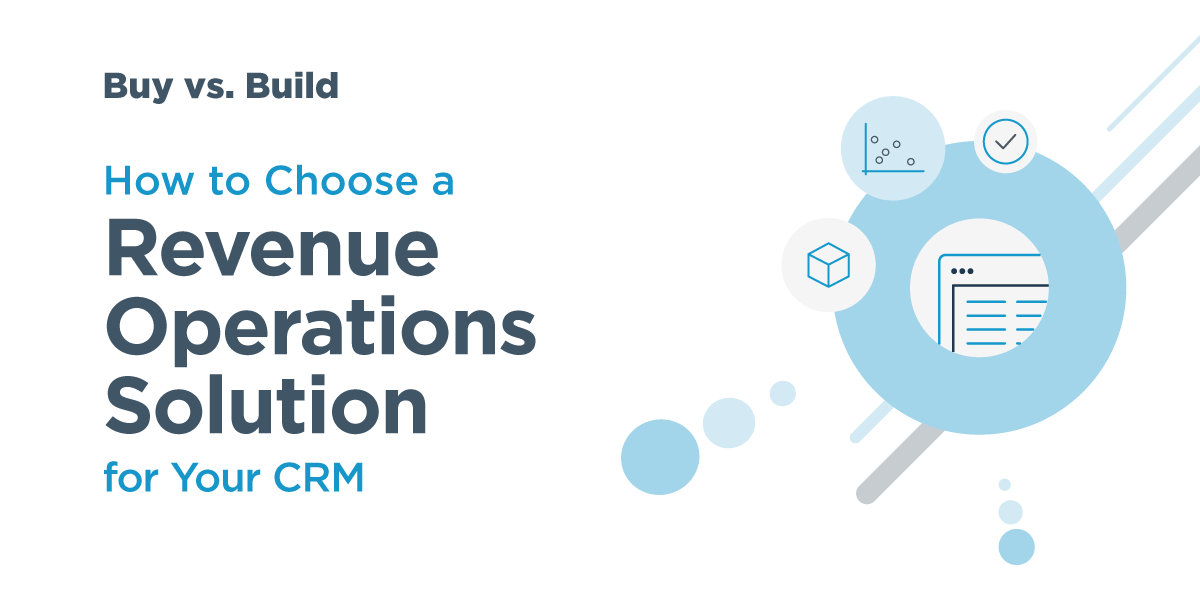Congrats, you’re ready to begin the path to modernizing your revenue process with AI! The endless meetings and debates around whether your CRM needs an AI and automation solution are over. You’ve determined an AI-based revenue operations solution is a clear must for your go-to-market teams to grow and retain revenue for your business.
But, now comes the difficult part. How do you adopt AI for your CRM? Do you build your own revenue operations solution internally on top of your CRM or purchase a ready-made solution instead?
Your decision is critical to the success of your go-to-market functions. With the right revenue operations solution and the right revenue operations framework, your revenue team will have constant command over the revenue process, allowing you to better manage your revenue motions, improve efficiency, and accurately predict revenue outcomes that set the pulse for the entire company.
However, with the wrong solution your revenue process could become a bottleneck for revenue growth and sustainability, causing negative downstream effects on hiring, product development, engineering, marketing, and more.
Buying versus building AI for your revenue process isn’t as easy as buying versus building a coffee table. It’s a bit more complicated than that. You need to really understand your companywide revenue management goals and assess the risks of building a solution internally.
Before we dive in, here’s some food for thought: According to this Forbes article, “if your goals are to have your AI handle routine activities and deliver immediate value, it’s almost never a good idea to build your own AI. Build-it-yourself AI can cost millions of dollars and it can take months to train a machine-learning algorithm to do what most vendors have already accomplished.”
In fact, the risks of a homegrown revenue operations solution for Chief Revenue Officers, sales teams, and the entire business may greatly outweigh the rewards.
What is a Revenue Operations Solution?
First things first: a little background on the importance of a revenue operations solution. A revenue operations solution gives you real-time visibility into your deals, as well as broad accessibility so anyone on the revenue operations team (and beyond) can see the engagement and activity levels of all deals. Revenue operations solutions use AI to analyze historical deal trends and patterns, so you know which deals are at risk, where to focus, and ultimately where you will land this quarter and next. You no longer need to wait around for someone else to build a report — it's all right there in one place.
Adding an AI-based revenue operations solution to your CRM is the way modern sales teams improve their data hygiene, save time, and replace the hodgepodge of untrustworthy spreadsheets and stale reports. With one unified system, revenue operations teams can align around the same numbers and predict revenue more effectively.
Risks to Consider If Building Your Own AI-based Revenue Operations Solution
If CRM isn’t supporting your needs, you may naturally be inclined to build your own, customized revenue operations system. While that is doable, be sure you take into consideration the following:
- Adoption rate: If a homegrown solution is made with little regard for user experience, it can result in low adoption rates. Most vendor-supplied solutions have been user tested to ensure an intuitive user experience and a workflow architecture that all members of the revenue operations team can understand.
- Time to implementation: Weigh the pros and cons of a long process of defining, scoping, and deploying a homegrown system versus an out-of-the-box solution. Long wait times may impair visibility into your revenue risk, while your revenue team could experience a delayed time-to-market schedule and lost opportunities. In addition, homegrown engineering and implementation resources may work for what you need today, but may prevent you from being agile and flexible tomorrow as your business grows and changes.
- Cost to build: Take into account the cost of implementation consultants, data warehousing experts, the many long hours of coding queries that will be required to stand up a solution, and the cost of not implementing a solution like Clari. When your engineers, data scientists, and other resources are spending time working on building an AI solution and costly integrations, you are taking away tens of thousands of hours that could be spent on core business objectives.
- Use cases by persona: Your entire revenue team should benefit from your solution in order to achieve the highest ROI. It’s imperative that the rest of the go-to-market team have dashboards and KPIs built for their needs. Evaluate what it would take to make sure the data, insights, execution, and predictive capabilities work for everyone on the go-to-market team to improve win rates.
- Accuracy of prediction: Predictive capabilities and machine-learning algorithms should be scientifically sound, backed by experts, and incorporate all data points and fields relevant to your sales process. A time-series data hub that snapshots every field across time is necessary to accurately predict revenue. These historical snapshots teach your AI through many iterations, queries, and thousands of flows before the machine gets it just right. Not doing these tests correctly could result in misleading information, incorrect data records, and faulty revenue reporting.
Building and maintaining a homegrown solution can come with great risks and may not pay off for many years after it is up and running. In the buy-versus-build dilemma, make sure you consider your primary company goals. Buying a solution can help you focus your resources on selling and creating value for your customers, while giving you the flexibility to adapt and change your revenue process as your business matures.
With a turnkey revenue operations solution like Clari, you can drastically transform the way you drive revenue growth and retention for your business.
To uncover more must-have capabilities to select the right AI-based RevOps solution for your business, download our ebook "How to Choose a Revenue Operations Solution for Your CRM" and supercharge your revenue process today.


